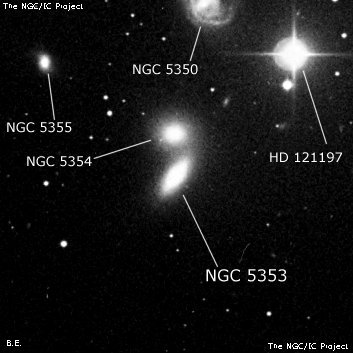
William Herschel discovered NGC 5353 = H II-714 = h1698 on 14 Jan 1788 (sweep 799) and recorded "Two [along with NGC 5354], pB, both S, R, at 2' distance in the meridian." JH logged "The southern of a double neb, dist 1' in meridian." and "pB; S; the southern of 2 nearly in meridian; the second of a group of 4."
200/250mm - 8" (5/21/82): moderately bright, small.
300/350mm - 13.1" (5/26/84): brightest in the NGC 5353 group = HCG 68. Fairly bright, oval 2:1 NW-SE, gradually increases to a small bright core. Forms a close pair with NGC 5354 1.2' N. Other nearby members are NGC 5350 4.9' NNW, NGC 5355 4.9' NE, NGC 5358 6.4' E. Located 4.8' SE of mag 6.5 HD 121197.
600/800mm - 24" (6/3/19): at 200x; type Ia SN 2019ein, discovered on May 1st, appeared as a mag 15 "star" just off the SE end of the galaxy (28" E and 28" S of center). This supernova peaked at mag 14.0.
24" (7/1/16): very bright, fairly large, elongated 5:2 NW-SE, ~1.8'x0.7', sharply concentrated with a very bright elongated core that increases to the center. Forms a contact pair with NGC 5354 (two brightest members of HCG 68), with centers 1.2' apart.
24" (6/8/13): the brightest member of HCG 68 appeared very bright, fairly large, elongated 5:2 NW-SE, 1.8'x0.7', well concentrated with a very bright elongated core that increases to the center. Forms a contact pair with NGC 5354 1.2' N. NGC 5358 = HCG 68E lies 6.4' due E. NGC 5371, the brightest and largest in a larger group (LGG 361) including HCG 68, lies 27' NE
Notes by Steve Gottlieb